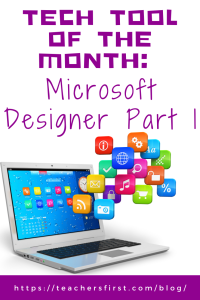Microsoft Designer is a simple-to-use, powerful AI tool that produces high-quality images based on your prompt. Use the chat box to input as much descriptive language as possible, click enter, and Designer will produce three or four images that match your prompt. Don’t like any of the options? You can generate a new set of images with one click. Designer has several prompt templates you can use to generate different styles of images (3D, flat, watercolor, etc.), or you can type the entire prompt yourself. You can also use Designer to remove backgrounds or erase and replace parts of an image. If you don’t have a free Microsoft account, you will be prompted to create one, but doing so allows you to download your images to your device or save them on Bing.
Applying the Triple E Framework
The Triple E Framework, created by Dr. Liz Kolb, asserts that “effective technology integration begins with good instructional strategies and not fancy tools” (tripleeframework.com). Dr. Kolb wrote a book, Learning First, Technology Second (ISTE, 2017), that lays out the three main uses of technology in education: to Engage, Enhance, or Extend learning goals. We can use this framework to decipher why we use specific classroom tools. Here is a rubric based on the Triple E Framework that you can use to evaluate whether Microsoft Designer (or any other technology) is a good fit with your learning goals and whether you should use it in your lesson.
- Engage in learning goals: Because there are no advertisements or other distractions, students can focus on the content and image creation. Designer helps students be active rather than passive learners by requiring them to enter prompts to create and share their AI-generated images.
- Enhance learning goals: Microsoft Designer creates pathways for students to demonstrate their understanding of the learning goals in a way that would be impossible without technology, as this tool is powered by AI. The tool also offers scaffolding, as students can generate new images until they formulate their prompt to produce the image they desire. It even gives students the option to remove backgrounds and edit the image to create a product that better fits their vision.
- Extend learning goals: Dr. Kolb describes extended learning as an opportunity for students to learn, connect, and collaborate outside the regular school day and as a way to create a bridge between school learning and everyday life experiences. Microsoft Designer allows students to build skills they can use in their future and everyday lives by giving them practice using descriptive language to articulate their vision for a desired outcome and using technology (specifically artificial intelligence tools) to create a product. Both of these skills can help students in future careers and courses.
SAMR Connection
The SAMR Model, created by Dr. Ruben Puentedura, suggests that technology implementation has four levels. We can use this model as a guideline to analyze how we use technology tools in the classroom. For example, you can use Microsoft Designer at all four SAMR levels, depending on what your students do. Let’s look at an activity where students create a drawing related to the results of a science experiment and explore how we can take this activity to the different levels of SAMR.
- Substitution: The substitution level is the most basic level of SAMR and refers to when technology acts as a direct substitute without any functional improvements. In our example, students would use Microsoft Designer to create their image rather than just drawing with a pencil on paper.
- Augmentation: At the augmentation level, the technology acts as a direct substitute and includes some functional improvements. We can take our example assignment to the augmentation level by using the features of Microsoft Designer that would be impossible without technology, such as the ability to reword their prompt and generate a new set of images if they’re not satisfied. They can also remove the background and edit the picture, which is only possible with technology.
- Modification: Technology moves to the modification level when it allows for significant task redesign. For example, we could modify our Microsoft Designer image activity by having students add their AI-generated image to a digital storytelling activity that can be shared with the class.
- Redefinition: At the redefinition level, the technology allows for the creation of new, previously inconceivable tasks. We could take our image activity to this level by having students share their finished images (and possibly the prompt they used) on a platform where more people can view it (such as on our class website, a Google Site, or Padlet) and allowing students to comment on each other’s images.
Don’t miss Part 2 of Tech Tool of the Month: Microsoft Designer, where we’ll discuss how to use the tool and classroom implementation ideas. In the meantime, let us know how you have used Microsoft Designer in your education setting in the comment section below.


